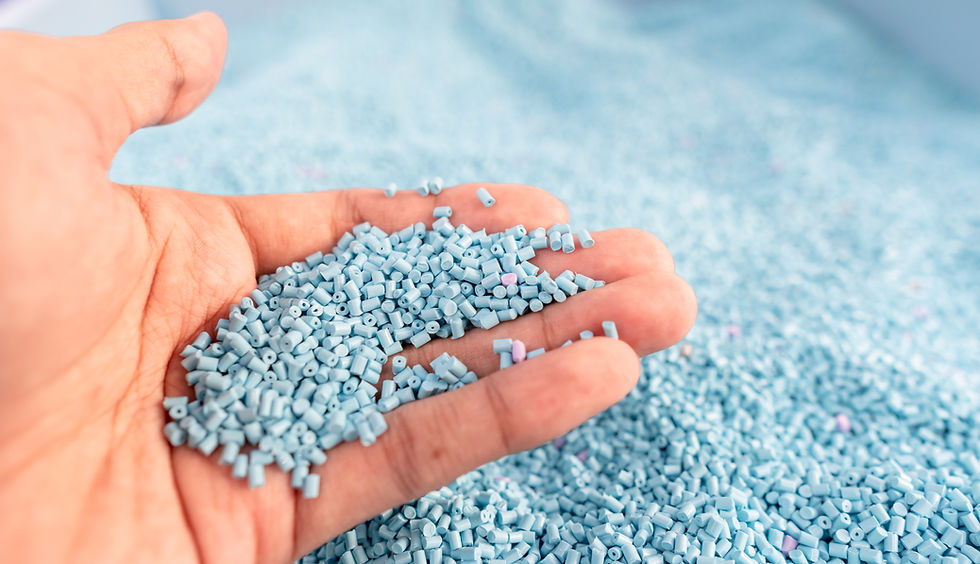Microplastics Are Now in the Brain—But What Are They Doing to It?
- Nicole Barney
- Feb 19
- 3 min read

Imagine sipping from a plastic water bottle, using a takeout container, or even just breathing in everyday air—without realizing that tiny plastic particles are silently making their way into your body. Now, new research reveals something even more alarming: microplastics are being found in human brains. And the potential consequences could be far more serious than previously thought.
Microplastics—tiny plastic fragments less than five millimeters in size—have already been detected in human blood, lungs, and even placentas. But until now, their presence in brain tissue was only theorized. A groundbreaking study published in Nature Medicine confirms what scientists feared: microplastics are not only crossing the blood-brain barrier but accumulating in brain tissue (source).
The implications? Possible links to neurodegenerative diseases, inflammation, and cognitive decline.
Let’s break down what this means, how microplastics are getting into the brain, and what can be done to reduce exposure.

How Are Microplastics Getting Into the Brain?
Microplastics enter the body through various pathways, including food, water, air, and even personal care products. These microscopic particles are present in bottled water, processed foods, seafood, and airborne dust. But how are they reaching the brain?
Crossing the Blood-Brain Barrier: The brain is protected by a highly selective shield called the blood-brain barrier (BBB), designed to prevent toxins and harmful substances from entering. However, the latest research suggests that nanoplastics—tiny fragments even smaller than microplastics—are bypassing this defense, potentially leading to inflammation and neurological disruption.
Inhalation: Studies show that microplastics are in the air we breathe, especially in urban environments. Once inhaled, they can travel through the olfactory nerve and reach brain tissue directly.
Ingestion: The food system is heavily contaminated with microplastics. Studies have found high concentrations in seafood, salt, tea bags, and plastic-packaged foods. Once ingested, these particles enter the bloodstream and can circulate throughout the body, including the brain.

The Link Between Microplastics & Neurological Damage
What happens when microplastics accumulate in the brain? Scientists are still piecing together the full picture, but early research suggests serious risks, particularly for cognitive health.
Increased Risk of Dementia & Neurodegeneration: The study in Nature Medicine found that individuals with dementia had up to 10 times more microplastics in their brains compared to those without the disease. While correlation doesn’t equal causation, this raises urgent questions about whether plastic exposure contributes to cognitive decline (source).
Inflammation & Oxidative Stress: Microplastics are known to trigger inflammation in various organs, and the brain is no exception. Chronic inflammation is a key driver of neurodegenerative diseases like Alzheimer’s and Parkinson’s, and microplastics may accelerate this process.
Disrupting Brain Chemistry: Plastics contain endocrine-disrupting chemicals (EDCs) like BPA and phthalates, which interfere with hormone function. Some studies suggest they may also impact neurotransmitters like dopamine and serotonin, potentially worsening mood disorders, anxiety, and focus issues.

How to Reduce Exposure to Microplastics
While it’s impossible to eliminate microplastics entirely, small, mindful changes can significantly reduce exposure. Here are the best strategies to lower plastic intake and absorption:
1. Filter Your Water
Tap water contains fewer microplastics than bottled water. Ditch single-use plastic bottles and use a high-quality carbon or reverse osmosis water filter to remove contaminants.
Avoid plastic water bottles and switch to glass or stainless steel.
2. Choose Whole, Unprocessed Foods
Microplastics are rampant in processed foods, especially those packaged in plastic.
Opt for fresh, whole foods and store them in glass, ceramic, or stainless steel containers.
3. Be Mindful of Cooking Methods
Avoid cooking with plastic utensils, non-stick cookware, and plastic-wrapped foods that release microplastics when heated.
Use wooden, stainless steel, or silicone cooking tools instead.
4. Reduce Airborne Plastic Exposure
Dust and indoor air contain microplastics from synthetic textiles, carpets, and household items.
Use an air purifier with a HEPA filter and regularly dust with a damp cloth to trap plastic particles.
5. Switch to Non-Plastic Personal Care Products
Many exfoliating scrubs, toothpaste, and cosmetics contain microbeads, which are microplastics that end up in the body and water supply.
Check ingredient labels and choose clean, non-toxic beauty and personal care products.

A Crisis Hiding in Plain Sight?
The presence of microplastics in the brain is an urgent wake-up call about the long-term effects of plastic pollution—not just on the environment, but on human health. While much remains unknown, the link between microplastics, inflammation, neurodegeneration, and hormone disruption is too significant to ignore.
Reduce plastic exposure where possible.
Prioritize clean water, whole foods, and safe cookware.
Stay informed as more research emerges.
The brain is one of the most protected organs in the body—yet microplastics are finding a way in. It’s time to take action to minimize exposure and push for stronger regulations on plastic use.



